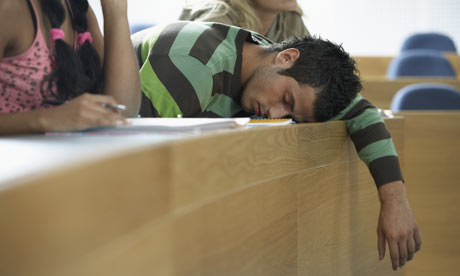
Students falling asleep in class is an age-old problem. How do you prevent this from happening and still keep your students interested?
What the Studies Say
Because consciousness is a prerequisite for learning, academic performance suffers from sleep deprivation. Even when kids are awake, the condition impairs concentration and cognitive functions. Additional effects include depression, increased appetite and weight gain, accidental injuries, and susceptibility toward nicotine dependence, among other problems.
Based on Russell Foster’s frequently-cited research showing that adolescents naturally tend to stay up later and sleep in longer, Mokkseaton High School, in the United Kingdom, changed its start time from 8:50 to 10:00AM, resulting in significant improvements in academics and attendance. When school start times were delayed as part of Finley Edwards’ study of North Carolina middle-grades students, standardized test scores were raised, especially among students with less than average academic skills. One way to narrow the achievement gap, Edwards suggests, might be a policy of starting middle and high school later.
From a number of articles on the subject, a checklist was compiled of common factors that contribute to teens chronically sleeping in class:
- Staying up too late (often attributed to games, TV, or social media)
- Working the night shift
- Suffering from health issues or sleep disorders: sleep apnea, restless leg syndrome, or narcolepsy
- Being bored with the pace of class activities
- Traumatizing parent-child relations or other troubling experiences
- Being too hungry
How Much Sleep Is Enough?
Nine or more hours of sleep are sufficient for most adolescents, according to multiple authorities, while anything under eight hours is not enough. Only eight percent of teens report that they receive enough sleep. Even more at risk are adolescents who physically mature more quickly because of their inherently lower sleep drive.
Waking Them Up and Keeping Them Active
Here is one way to compassionately wake a student. Preoccupy the rest of the class with a think-pair-share, and while everyone is distracted, lightly touch the sleeper’s arm. To help her stay awake, suggest she get a drink of water, stretch in the back of the room, or sit with her back against a cold wall.
When students start to space off, switch to an activity that requires movement.
- Have students briefly engage in a role-play.
- Play an activity called ‘Chat Stations’, which students stand and discuss prompts located in different parts of the room. After a few minutes, rotate the small groups to the next station.
- Try a new activity.
Short energy breaks, or energizers, can enhance alertness and reduce stress. The options below features some favorites:
1. In ‘Question Ball’, students stand in a circle. When the facilitator bounce-passes a ball to someone, the receiver asks a peer a question. “Your house is burning and you can retrieve only one object. What do you carry to safety?” Then the ball is returned to the facilitator who passes it to someone in the circle who hasn’t had a chance to ask or answer a question. This continues until everyone has spoken.
2. Play a game called ‘What Is the Adverb?’ A student volunteer is sent into the hall while the rest of the class agrees on an adverb, such as painfully, tensely, suspiciously, sadly, selfishly, etc. When the volunteer returns to the room, she commands peers to do various actions “in that way.” Examples:
- Distribute papers that way.
- Simulate holding up a bank that way.
- Greet a friend that way.
- Scrutinize someone’s shoe that way.
The round ends when the volunteer correctly identifies the adverb.
And If the Sleeping Continues?
Assuming you’ve a) had a conversation with the classroom sleeper about why she can’t stay awake; b) notified the child’s parents about which days and how often you’ve observed the problem; and c) that your lessons incorporate variety and movement; send these sleep hygiene routines to the caregiver if the problem persists. Meanwhile, make sure that your classroom (especially for those meeting earlier in the day) is well lighted to increase alertness, using natural light if possible. If you have any other suggestions, please post them in the comments section.
 Blog EBE English Book Education
Blog EBE English Book Education



